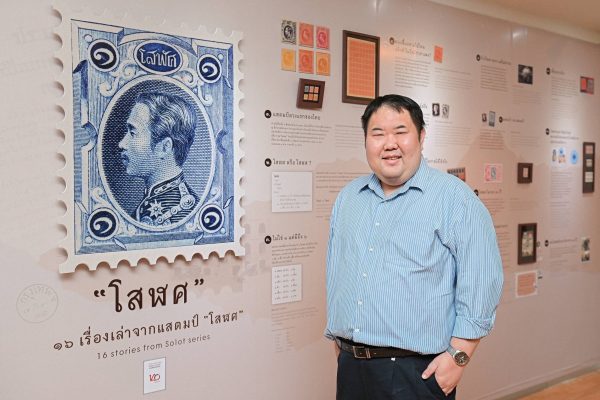Leveraging postage stamps as a soft power to boost the economy

For the past several years, postal service providers around the world have faced new challenges as digitalization has taken hold, a situation that significantly accelerated during the Covid-19 pandemic. The internet and social media platforms that make communication today much easier and faster have brought traditional letter writing almost to a halt, reducing the demand for so-called ‘snail mail’ and postage stamps.
Like its peers around the world, Thailand Post has felt the pinch.
“Thais do not seem to enjoy writing and mailing a letter to communicate with friends and family like they used to. But most of the Japanese still do it,” said Pasu Unhanandana, chief commercial officer of Thailand Post.

The number of letters distributed in the country has declined by 9% per year on average, he notes. The agency saw its revenue earned from the sale of postage stamps drop dramatically over the past few years.
From prepayment to the nation’s soft power
Thailand Post has improved and streamlined its operations in a bid to boost its revenue through the adoption of innovations and technology and by combining digital elements with its products and services. The agency has also run creative activities and events to try and increase public interest in philately.
Pasu said his agency has decided to promote its postage stamps as a source of the country’s soft power and is focusing on issuing limited editions of stamps to draw the attention of collectors around the globe.
“Thai postage stamps are special. Many of them are rich in design and history. Some are unique in printing techniques and materials. They attract a lot of attention from both local and foreign philatelists. That’s why they should be promoted as a soft power of the nation,” he said, adding that the functions of postage stamps have rapidly changed over the past few years due to digitalization.
In addition to its basic function that signifies the appropriate payment made for the service of transporting a letter, the postage stamp has long played a role in celebrating anniversaries, commemorating important events and promoting national Thai heritage and culture. Stamps also illustrate the most beautiful places, animals, plants and even foods: in short, everything of which the country is proud. Stamps are also an important factor in creating positive relationships and emotions among people.
Thailand Post has issued a comprehensive range of stamps with a wide variety of themes to attract the attention of philatelists and young new collectors.
Recently, the agency launched a theme that reflected the Covid-19 situation that has been welcomed by collectors. The stamps depict the collaboration between the various parties and thank medical personnel for their valuable help and support in fighting the pandemic. Earlier this year, it issued a e-sport theme to mark Thai National Children’s Day to draw the attention of gamers.
“Stamps are more than just a means of paying for postage. They can be little works of art. Some are valuable items much desired by collectors,” Pasu said.
Changes in the environment have also influenced consumer behaviour and encouraged many to try something new. In response to this, Thailand Post has created an ‘iStamp’ service that enables people to create their own stamps via their smartphones that can be used for mailing while also providing a personalized postal stamp experience.
Thailand Post is working to create an online platform that will serve as a community for philatelists to exchange stamps and information as well as initiate discussions on collections and provide advice.
In addition, the agency plans to work with some famous designers and artists on special postage stamp projects to create collections to impress new budding collectors.
Adding stamps that can be used as digital assets for collections or NFTs (non-fungible tokens) is also part of its plan. In 2022, Thailand Post issued collectible crypto stamps, the first NFT stamps in ASEAN.
Jenwit Apichainunt, vice president for activities of the Philatelic Association of Thailand under the Patronage of HRH Princess Maha Chakri Sirindhorn, noted that most philatelists place greater emphasis on the value of stamps than their basic functions.
“Stamps tell stories and keep history alive. They are like tiny paintings in frames used to depict or commemorate special occasions. They are much cheaper than a real painting, making them affordable and reachable. Each stamp has unique features and an inherent beauty and design. They are worth collecting,” he said.

The philatelist urges people to start keeping stamps as collectables, pointing out that there is money to be made. According to him, the value of stamps relies on the market demand, their age, condition, the number of prints and the stories behind them.
Artist Mayuree Narknisorn says designing and developing postage stamps is challenging and fun. Several themes on which she has worked inspired new challenges in technological development by improving traditional printing techniques, introducing new technologies and materials and adapting digital technology.
“We believe this provides a unique and valuable experience to philatelists,” she said.
Mayuree, who has collaborated with Thailand Post for more than two decades on postage stamp projects, said the job also allows her to work with leading artists and influencers.
Celebrating 140 years of success
Today, Thailand Post is celebrating 140 years of its operations and development. The colourful history of the Thai postal services can be traced back to the reign of King Rama V when the royal government established the Post and Telegraph Office in 1883 and issued the country’s first set of stamps – “Solot” and the very first postcards. Since then, the office has undergone several changes and developments.
To mark the auspicious occasion, increase awareness about the roles of the Post in the everyday lives of people and businesses, and show how it contributes to the country’s social and economic development, the agency has been running a special philately exhibition at the Thai National Postal Museum, aka the Sam Sen Nai Philatelic Museum located on the second floor of Sam Sen Nai Post Office. The exhibition showcases the origin of Thai postage stamps, stories of the “Solot” series and 16 remarkable things you need to know about them. Solot means “16” which was the currency unit in ancient Siam.
At the event, visitors can also enjoy creating a virtual stamp collection and designing their own stamp through the iStamp service. The exhibition runs through October 29 and admission is free.
To mark the special occasion, Thailand Post has printed two sets of the Solot series. The first series was put on sale on September 20 to coincide with the birthday of HM the King Rama V, the founder of the Thai postal service. The second series will be made available on November 27 when Thailand hosts the International Stamp Exhibition at the General Post Office in Bangkok’s Bang Rak area.
The International Stamp Exhibition will run from November 27 to December 3. The highlights will be an exhibition displaying the personal collections of HRH Princess Maha Chakri Sirindhorn and an exhibition that showcases a series of the most valuable stamps in the world, the most expensive stamps in Asia and the most sought-after stamps in Thailand.
By Thai PBS World Feature Desk






